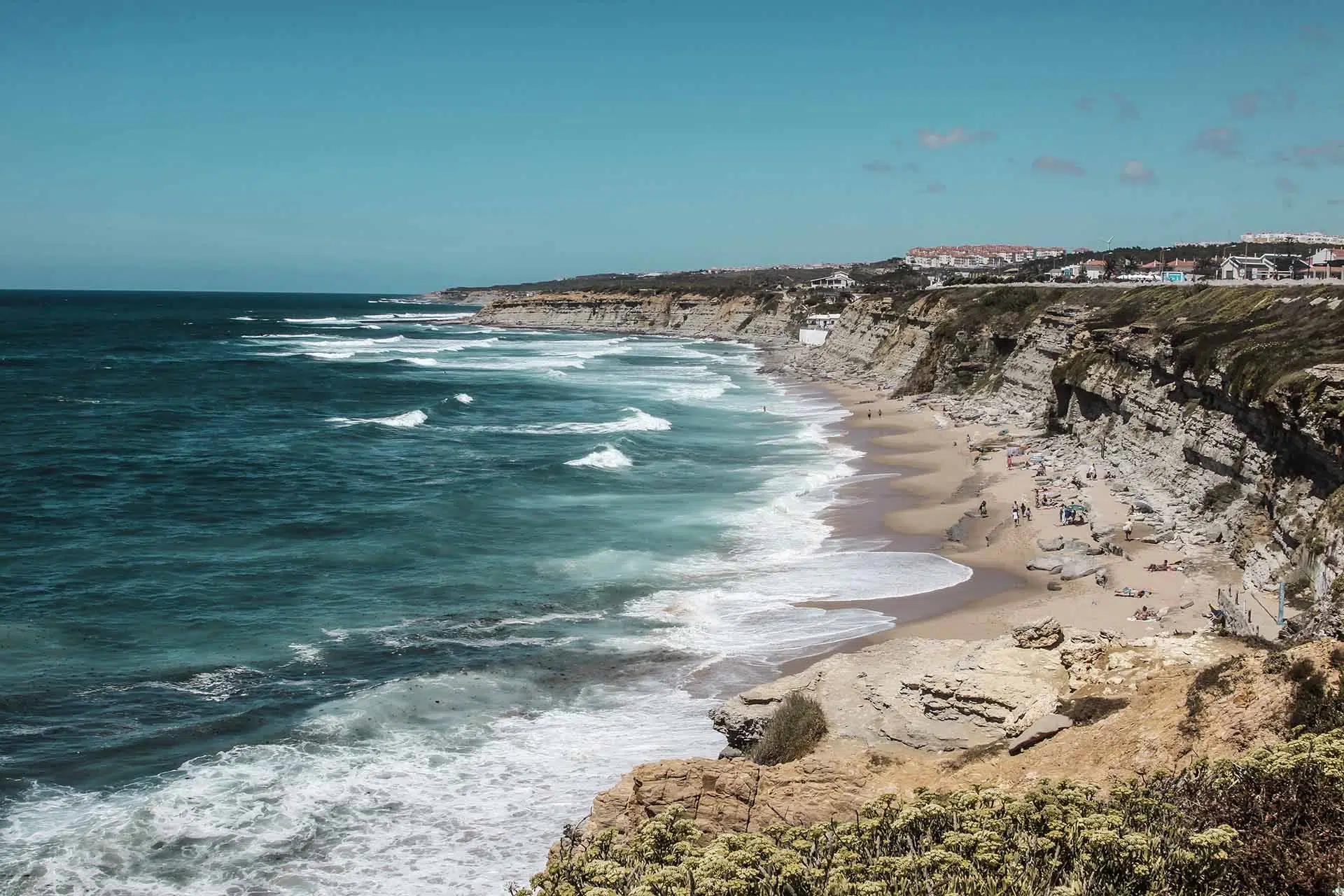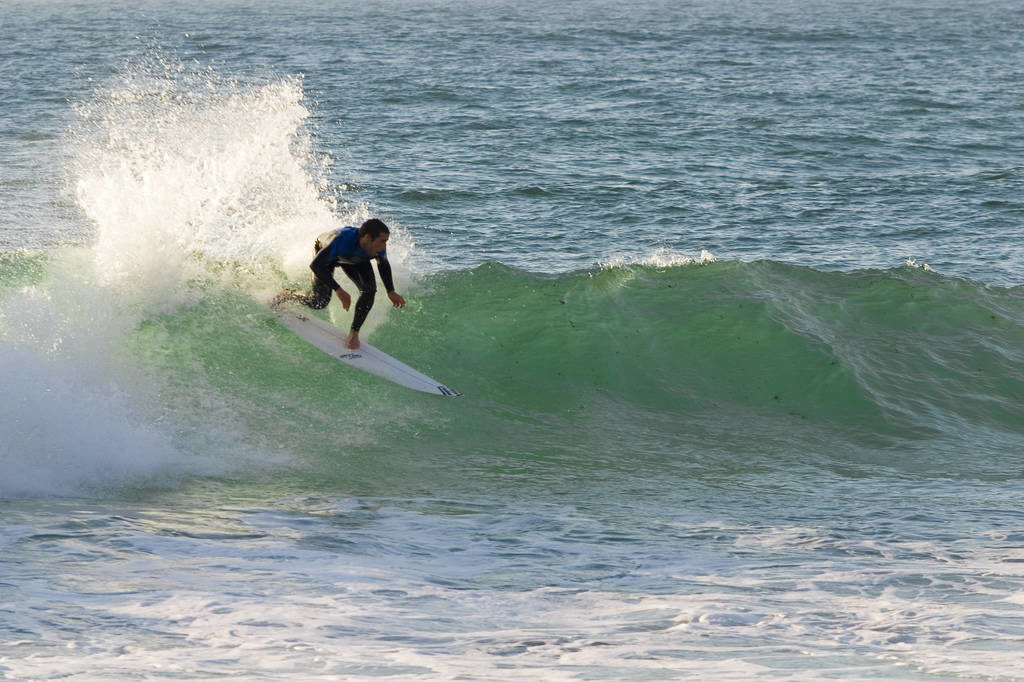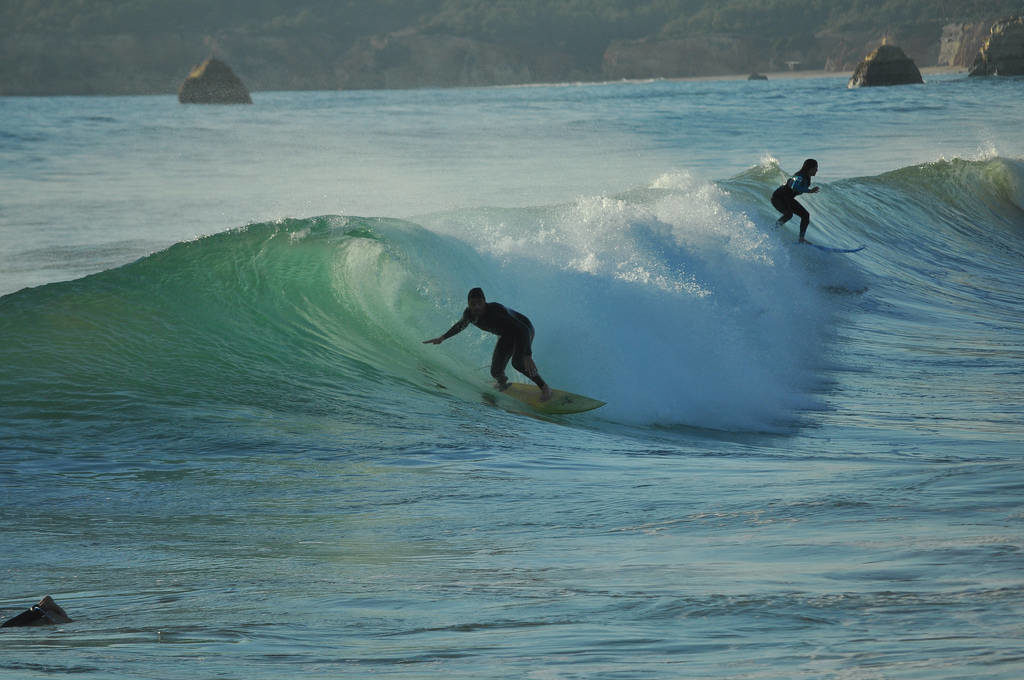Looking for Europe’s best waves? In our guide to surfing in camps Portugal we’ve got the low-down on where and when you can find them. Not including its islands, Portugal boasts 943 kilometres (586 miles) of coastline, which is dotted with countless incredible surf breaks.
The most popular surf spots in Portugal are located in 3 main places: Ericeira, Peniche and the Lisbon coast. Some of the smaller yet amazing spots include Algarve, Alentejo and Porto, which are also home to some serious waves, as are the Azores islands and the Madeira archipelago. The entire continental coast of Portugal is well respected for its year-round consistency and will not disappoint even the most discerning and jaded of surfers.
Brief History of Surfing in Portugal
Portugal’s first national surfing competition was held at Ribeira d’Ilhas in Ericeira in 1977. While that might sound very recent, consider that we are talking about European surfing and specifically a country that was under a somewhat isolated dictatorship until 1974. Portugal really began to put itself firmly on the international surfing map during the 1990s when the sport exploded in the country.

Seasons for Surfing in Portugal
You’ll see people surfing Portugal year round, even during the more crowded summer months when it seems like entire country, along with many foreign visitors, comes to fill the its many beautiful beaches. However, the waves are better outside of summer even if the weather can get a bit too cool for casual swimmers and sunbathers.
Which is the best season for surfing in Portugal for beginners?
For beginner surfers the best time of the year to go is summer. This is when the swells are less frequent and the waves are smaller. Summer waves average around 1 – 1.5 meters (3 – 5 feet) with notable exceptions like Nazaré’s Praia do Norte, site of many big wave surfing world records. In June – August the most popular surf schools might get very crowded, especially on the central coast and on the beaches near the capital.
What’s the best time for surfing in Portugal for experts?
For experienced surfers the ideal surf season is late winter to early spring, especially between September and April. During these months swells are definitely more powerful, producing giant waves measuring around 2– 4.5 meters (6 – 15 feet) that are better left to advanced surfers.
Where should you go surfing in Portugal?
The Portuguese coast can be divided into 7 surfing regions. Each of these regions have a number surf camps which offer all kinds of accommodation facilities including private rooms. Most of them offer at breakfast buffet along with other meals, depending on the facility. A lot these surfing camps in Portugal offer a holistic surf and yoga experience.
1. Costa Verde or “Green Coast”
This is Portugal’s northern coast, associated with the country’s second largest city, Porto (Oporto). It is immediately north of the Costa de Prata and reaches all the way to the Spanish region of Galicia. Surfing around Porto may take place in colder waters and it has a variety of surf spots available. Notable spots include Aguçadoura, Cabeldo Beach near Viana do Castelo, Azurara near Vila do Conde, Espinho, and Matosinhos (accessible via Porto’s metro system).
2. The Costa de Prata or “Silver Coast”
This extensive stretch of coastline begins north of Ericeira and continues all the way up to the south of Porto at Esmoriz. Notable surf spots in this central coastal region of Portugal include big wave capital Praia do Norte in Nazaré; the legendary Supertubos in Peniche (home of the Moche Rip Curl Pro Portugal); Cortegaça, with its consistent surf and night surfing festival; and the numerous spots around Figueira do Foz and Aveiro.
3. Ericeira
Simply put, surfing Portugal = surfing Ericeira. This is Portugal’s — and arguably Europe’s — surfing capital, so anyone on a surf trip in the country would be crazy to skip Ericeira!
At 8 kilometres (5 miles), the smallest surfing region in Portugal is Ericeira, but it is also the one with the highest number of world-class surf spots. Ericeira boasts 9 spots that are famous throughout the global surfing community plus several other notable breaks.
Besides being Europe’s only dedicated World Surfing Reserve, Ericeira also hosts the ASP World Tour Surf Championship at the legendary Ribeira d’Ilhas beach, known for its near perfect barrels. Experienced, expert and pro-level surfers will also fall in love with Coxos, Cave and São Lourenço, while beginners and the less experienced can learn to surf and sharpen their skills at Foz do Lizandro, São Julião and Praia do Sul.
You can stay at Rapture Camp properties in Ericeira to enjoy an unmatched surfing experience complete with Yoga sessions.
Surf Portugal With Rapture Surfcamps
4. Lisbon Coast
Only around 50 kilometres (30 miles) south of Ericeira’s incredible surf spots is the Portuguese capital, one of Europe’s thriving cultural centres. Lisbon itself is not to miss, while the Lisbon coast is well worth a visit for its excellent surfing, especially if you’re already in Ericeira. The Lisbon area offers excellent surf all year long. Highlights include great breaks at Estoril, Carcavelos, Praia do Guincho, Praia Grande in Sintra and Praia das Maçás. For smaller crowds and nice beach breaks, head over the Tagus River to the district of Setúbal to surf the Lisbon area’s west coast, particularly the Costa da Caparica.
5. Alentejo Coast
Much of Portugal’s coastline is reminiscent of the California coast. But none more so than the Alentejo region, which can resemble the quieter spots of the SoCal surf scene. South of the Lisbon region and north of the Algarve tourism hub. Alentejo is well known for its excellent wines, delicious cuisine and idyllic natural features. There are many great spots along the Vicentine Coast Natural Park, which is located in both Alentejo and the Algarve. Highlights in the Alentejo section include Odeceixe, Zambujeira do Mar, São Torpes, Arrifana and Vila Nova de Milfontes.
6. Algarve Coast
Famous as a tourist paradise for Northern Europeans as well as for portuguese, the southernmost region of Algarve may not be as famous for surfing as, for example, Ericeira. However, there is some very good surfing to be had! If you like your sun brighter and your water a bit warmer, Algarve is worth a shot. Especially on the west coast, which gets north-westerly swells. The south coast can also get nice waves in the winter. Which is the best time to avoid the huge summer crowds anyway. Choose from over 50 surf spots in this unique and beautiful holiday mecca. For beach breaks and medium southerly swells, try Sagres, which is also home to the most south-westerly point in continental Europe; and Lagos, a nice-sized city with plenty to do besides surf. The Algarve’s west coast waves include nice beach towns such as Arifana, Tavira, Monte Clergio and Carrapateira.
7. The Islands: Azores and Madeira
Though both figuratively and literally off the beaten path, the Azores islands and Madeira archipelago offer unique experiences. Also for travel destinations besides places to surf.
Around 1,360 kilometres (850 miles) west of continental Portugal, the Autonomous Region of the Azores is made up of 9 islands. Each island with its own character. The island of Terceira boasts a cluster of surf spots on its east. The northeast coasts (São Miguel) features what are the archipelago’s most well-known breaks: powerful and consistent Ribeira Grande and Rabo de Peixe. They are both on the island’s north coast. Crowds are small and the surfing can get big and dangerous, especially in the winter, so take care!
Situated in the North Atlantic Ocean some 950 kilometres (600 miles) from mainland Portugal, there is Madeira. An Autonomous Region that contains two populated islands: the main island of Madeira and Porto Santo. Most surfing takes place on the main island, with the most famous spot being the barrelling Paul do Mar.
This island has played host to the ISA World Championships and big wave surfing competitions. Other spots include the expert-level Jardim do Mar, Lugar de Baixo and Ponta Pequena. For beginners and intermediates there is the calmer São Vicente, located on the north coast.
In addition to the exceptional surf, many of these regions offer surf camps that provide holistic experiences, including yoga sessions and accommodation facilities.
Whether you’re a seasoned pro or a beginner looking to catch your first wave, Portugal’s diverse coastline and consistent surf will not disappoint. So, grab your board, head to the waves, and experience the thrill of surfing in this European surfers’ paradise.
Looking for surf camps in Portugal? Rapture Surfamps has got you covered with great surf lessons, excellent stay options and a relaxing ambience. Book your stay today!

Visit our Surfcamp in Ericeira SURF SCHOOL
Join us in Portugal and learn the art of surfing in one of the best surf spots in the world
Portugal is well connected with regional rail and bus lines. Greater Lisbon and Porto have modern and efficient systems of trains, buses and metro lines.
CHECK OUR CAMPFAQs About Surfing in Portugal
The prime time for surfing in Portugal is from late September to April, with consistent swells and favourable weather conditions. However, the summer months (June to August) are also popular, especially for beginners, due to warmer water and smaller waves.
Beginners can enjoy surf lessons at spots like Praia da Costa Nova, Praia do Guincho, and Praia de Carcavelos. These beaches offer relatively gentle waves and are ideal for those learning to surf.
Experienced surfers often head to iconic spots like Nazaré, known for its massive waves, Supertubos in Peniche, and Coxos in Ericeira. These locations provide challenging conditions for advanced surfers.
Nazaré is renowned for its massive waves, attracting big wave surfers from around the world. The underwater Nazaré Canyon funnels and amplifies swells, creating extraordinary surf conditions. The infamous Praia do Norte beach in Nazaré is where record-breaking waves have been surfed.
Absolutely. Portugal offers a variety of surf camps that provide a complete surfing experience, including accommodation, lessons, and a vibrant surf culture. These camps are suitable for all levels, from beginners to advanced surfers.






